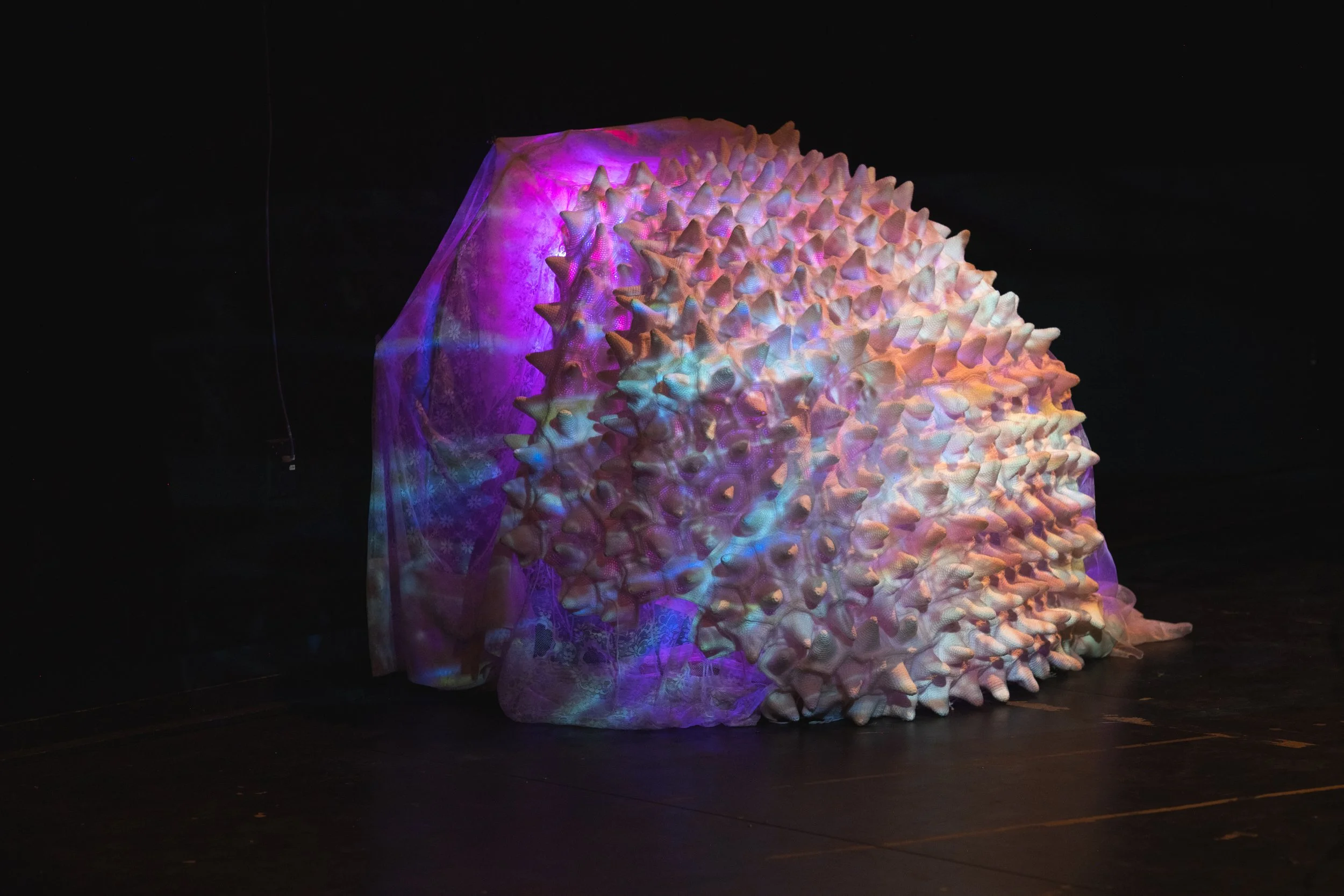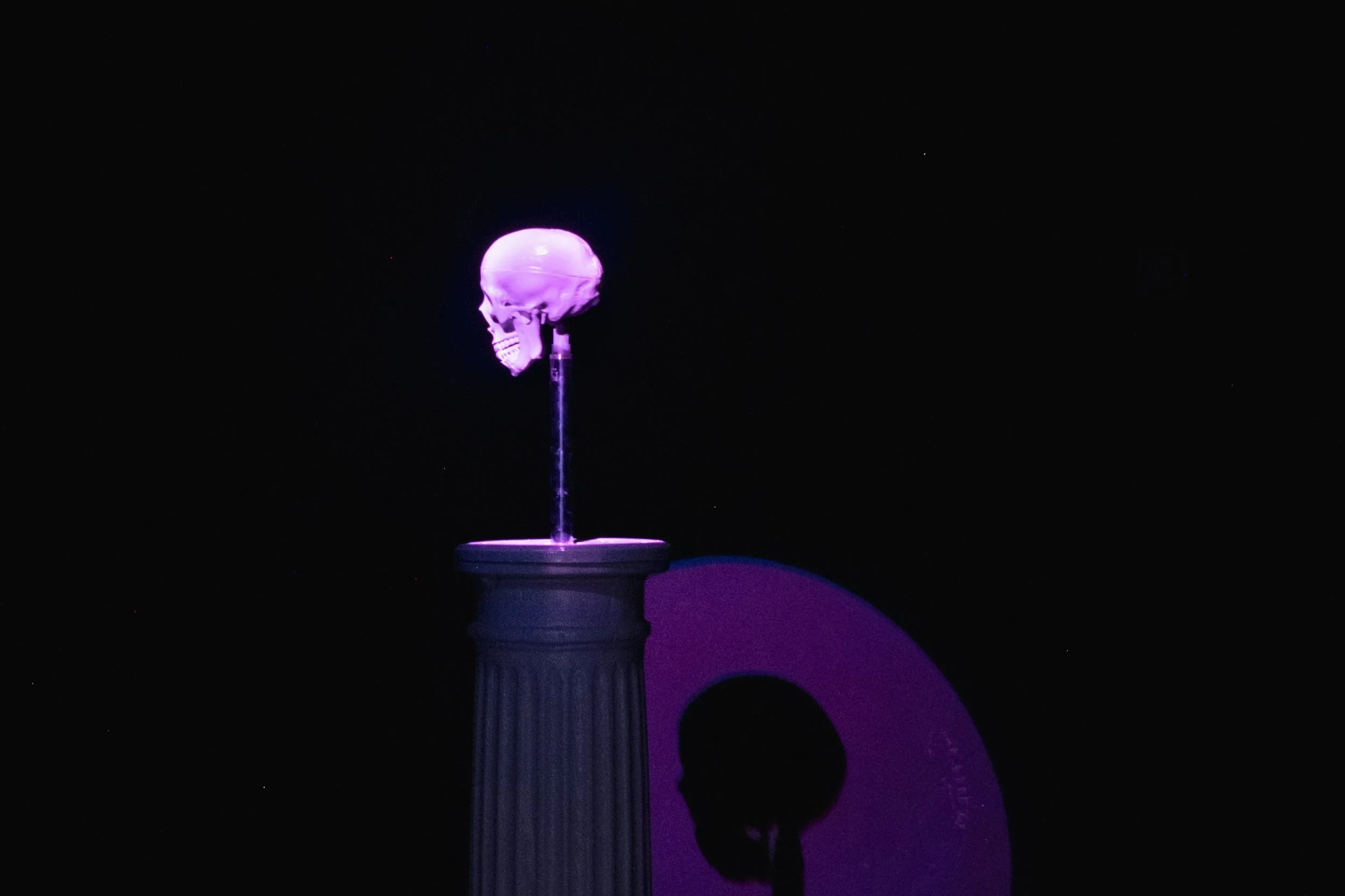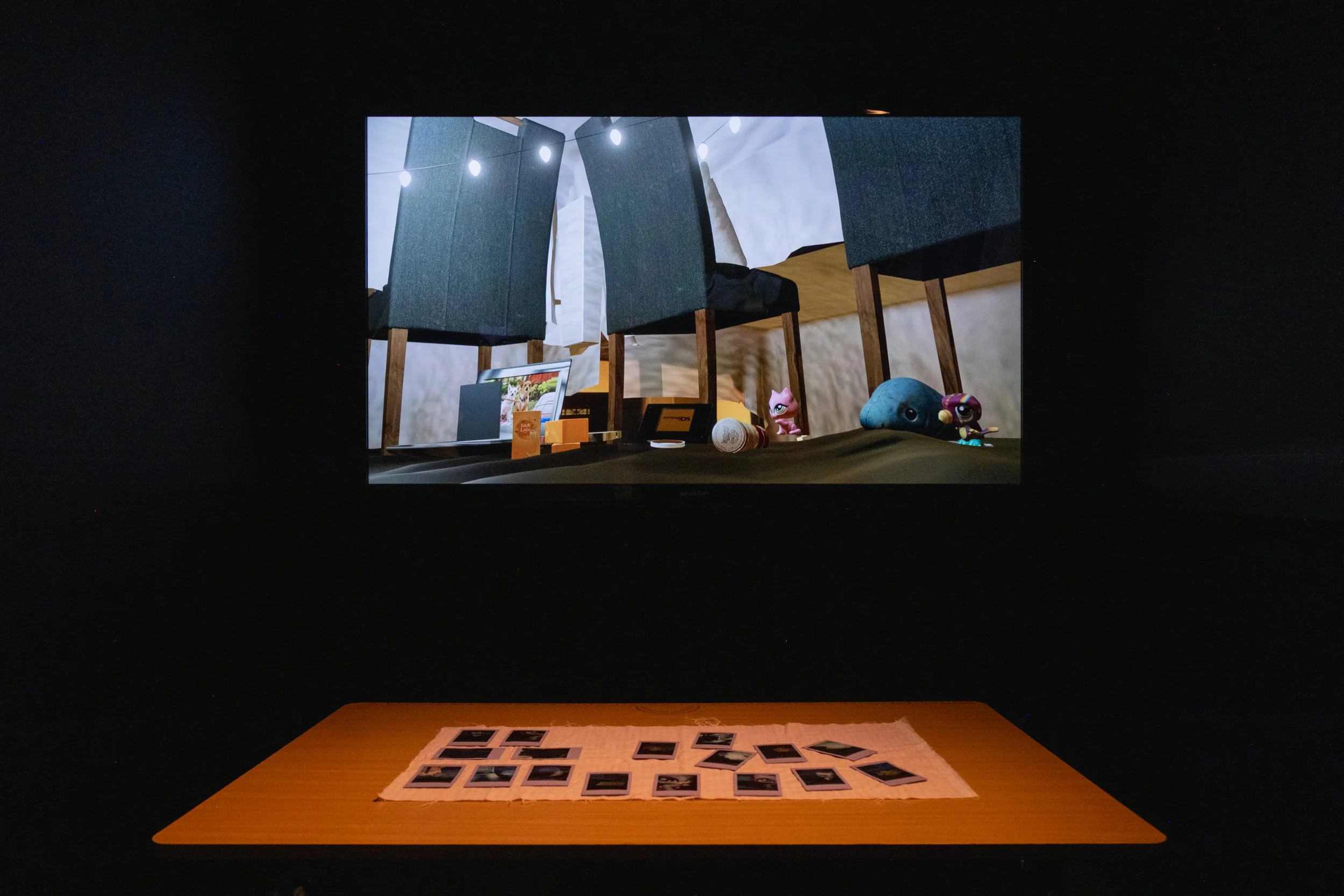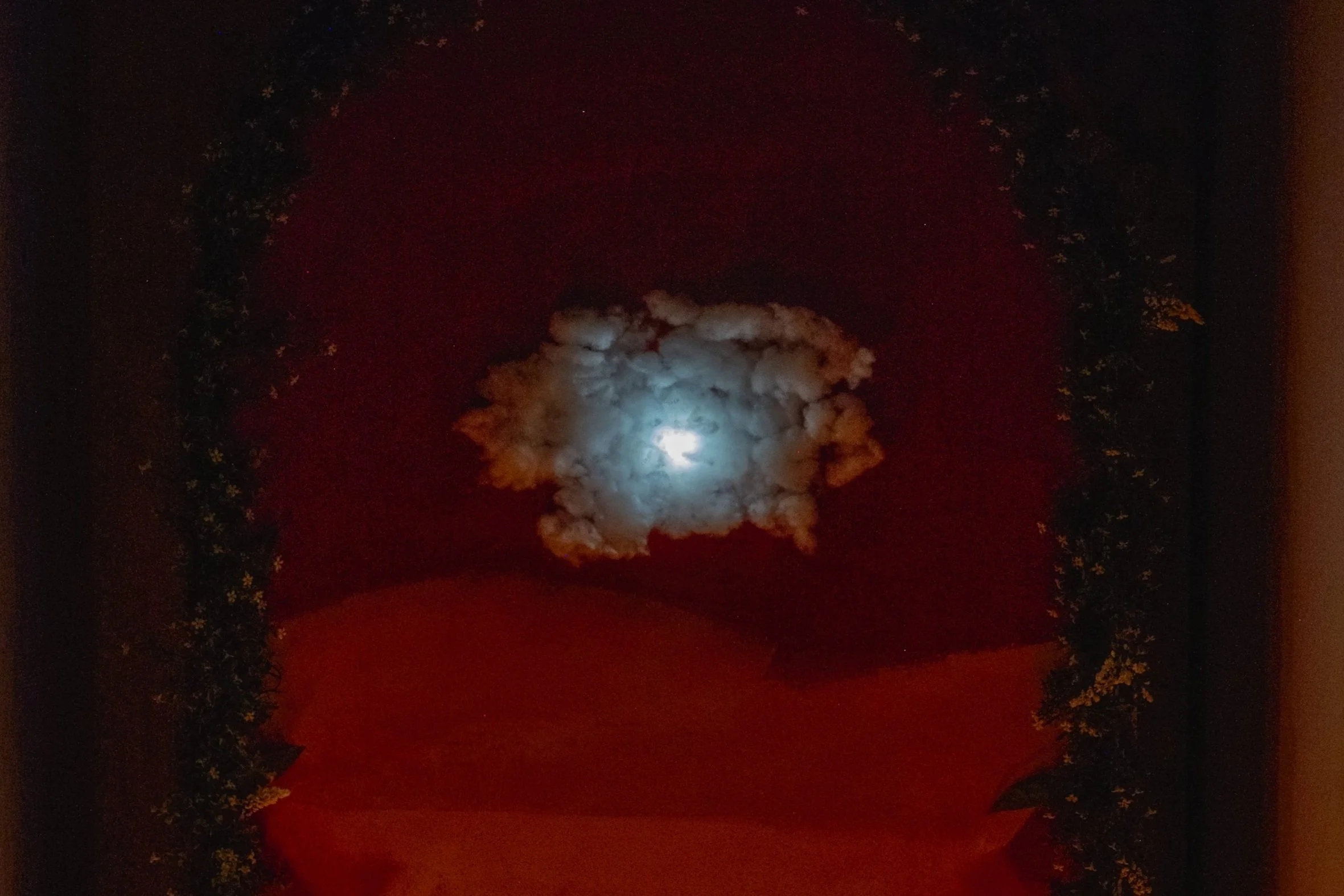Terms and Conditions: Curatorial Essay for the 2025 Undergraduate Intermedia Exhibition “Accept All Cookies”
To Accept All Cookies is to leave behind a trail of data, but what can that data tell us about ourselves? If we step back to analyse the terms and conditions, to look at the footprints we leave behind, what can we learn? Accept All Cookies is an exhibition composed of the graduating class of the undergraduate program in Intermedia (IMCA) at Concordia University. The artists in Accept All Cookies strive to understand their pasts and the conditions that have bracketed them. Through questioning the affective and embodied impact of the separation of nature and technology, and the mundane uses of technology and the state of digital culture, the IMCA 2025 cohort seeks to understand their conditions so they may reclaim them.
The Conditions are as follows:
Materials Frame Perception
The affective and embodied impact of digital materialities is questioned in the works of Parsa Fard, Morgan Kobayashi and Obediah Anderson. These artists observe how the construction of experience and memory is shaped by digital materials. They reject the idea that electrical media is immaterial, and instead highlight materiality by deconstructing the moving image and the electricity that powers it.
1.1 In his work Moving Image Fountain, Parsa Fard expands the limits of the video frame by using flowing water as a canvas for the light of a video projector. He proposes an alternative means of experiencing the moving image, desiring to question the material limits of video spectatorship. Fard rejects the video frame’s immersive qualities, purposefully pulling video into space instead of the viewer into video.
Parsa Fard, Moving Image Fountain. Photographed by Mara Zapata.
1.2 Morgan Kobayashi’s work 2889a Danforth Ave continues this thread of questioning the impact of the conventions of image consumption. In his installation, Kobayashi juxtaposes archival home footage of his childhood home with a Virtual Reality experience projecting this home footage into a distorted virtual space. 2889a Danforth Ave explores the fallible nature of memory as memories are warped by their recollection. The use of VR in this work creates an uncanny space in which the abstract idea of memory can become a sensory-oriented experience.
Morgan Kobayashi, 2889a Danforth Ave. Photographed by Mara Zapata.
1.3. Obediah Anderson takes an opposite approach in his work, Tuned and Shielded Shine. In this work, Anderson abstracts the sensory by deconstructing and intersecting text, concert footage, and live electroacoustics. By separating and spatializing the individual components of live music, Anderson centers and celebrates the underlying connection between these elements: the flowing power of electricity itself.
Obediah Anderson, Tuned and Shielded Shrine. Photographed by Mara Zapata.
Collapsing the Boundary of Nature/Technology
Artists emma willow, Nico Butel-Marchildon, Jiwoo Lee, Yuki LN, and Tara Halkiw construct hybrid digital-natural bodies to use as sites for exploration of the interconnectedness of all things. These artists collapse the space between the natural world and notions of technology. Utilizing spatiality and the juxtaposition of natural and digital elements, they attempt to release us from the idea that nature and technology exist as two binary opposites.
2.1 Nico Butel-Marchildon’s installation NATURA MOBILI: Playful Beings calls for a return to the youthful ritual of celebrating natural technologies. This installation emphasizes the intelligence of natural life and viewing nature as a source for creative inspiration and personal fulfilment in difficult times. Butel-Marchildon asks viewers to step forward to touch the maple seeds, so they too may view nature as a muse for humanity, as a source for deeply rooted forms of intelligence.
Nico Butel-Marchildon, NATURA MOBILI: Playful Beings. Photographed by Mara Zapata.
2.2 Yuki LN’s multisensorial sculptural workドキドキeternal calm〜!! explores how natural technologies evolve under environmental stressors. Inspired by the evolution of the structure of snowflakes under climate change, Yuki LN constructs a structure that transcends traditional classification, a structure that is both electronic and organic, eternal and alive. The sculpture reacts to the presence of its viewers, creating a being that hybridizes and morphs under the pressure of human presence.
Yuki LN, ドキドキeternal calm〜!!. Photographed by Mara Zapata.
2.3 The pressure of human presence on the natural world is further deconstructed in emma willow’s work What Do You See Beyond Form? In this work, willow laments the destruction of the natural world they care deeply for. She represents the strong desire to hide herself from the world in the face of such soul-crushing issues through the construction of her soft crochet shell. The light projected onto the structure represents willow’s realization that light permeates and connects all and that, ultimately, it is through allowing light, hope, and vulnerability to come through that we may share collective experiences that inspire us to move forward together.
emma willow, What Do You See Beyond Form?. Photographed by Mara Zapata.
2.4 Jiwoo Lee’s two-channel installation brings the video frame and natural scenes into dialogue using spatial juxtaposition. Lee revisits places that resonate with her personal history; she frames, cuts and isolates an aspect of the scene spatially across the two channels. By deconstructing these personal scenes in this way, she creates a shadowy distance between aspects of a singular place. It is as though Lee is recalling a place from a distance, speaking to themes of nature, memory and spatiality.
Jiwoo Lee, Untitled. Photographed by Mara Zapata.
2.5 Tara Jade Halkiw’s Rupture questions where the boundary lies between a natural humanity and one determined by technological intervention. Halkiw proposes that our embodiment is deeply affected by digital saturation in all aspects of life. By creating an ever-shifting space of human movement and technological intervention, she illustrates the persistent tension between humanity and the technologies that increasingly control more aspects of our existence.
Tara Jade Halkiw, Rupture. Photographed by Mara Zapata.
Stipulations of the Digital Ecosystem
Grace Stamler, Laeticia Shosn, Henri-Philippe Laverdure, Carlo Lombardo and Christophe-Wilner Paris probe digital culture, asking what are the conditions of our shared digital landscape? Questions arise about the state of political culture, celebrity, AI, and the role of traditional mass media in our current times. How are these aspects of digital culture shaped by larger systemic issues, and how might we use notions of humour, absurdity and home as a means of deconstructing these monumental systems to make these topics accessible?
3.1 Henri-Philippe Laverdure Libération du Saint Royaume de Québec satirizes the landscape of Quebec politics, particularly as it relates to inflammatory political discourse on the internet. He creates two absurd personas who do not speak the same language but contain the same insatiable appetite for discourse and argument. Laverdure employs these absurd, eccentric characters to reflect the real-world strategies of public figures that rely on spectacle.
Henri-Philippe Laverdure, Libération du Saint Royaume de Québec. Photographed by Mara Zapata.
3.2 Grace Stamler’s Cake It presents celebrity culture as a manifestation of the never-ending capitalist urge for consumption. Celebrity idols are turned into cakes to be quickly worshipped, consumed, and spit back out again in a continuous cycle. The work is colourful, nauseating and absurd, an ode to the false veneer capitalism uses to reinforce itself.
Grace Stamler, Cake it. Photographed by Mara Zapata.
3.3 Christophe-Wilner Paris’s sculptural installation My Brain&AI manifests the human brain as a machine. It attempts to visualize a parallel with the human mind’s orientation towards a causal way of thinking and the input-output oriented nature of AI algorithms. He interrogates technology, questioning where the place of instinct is in this algorithm.
Christophe-Wilner Paris, My Brain&AI. Photographed by Mara Zapata.
3.4 Carlo Lombardo’s project Septem further investigates the algorithmic thought process of AI by perpetually asking existential questions the AI is incapable of answering. Lombardo combines the human impulse for clear answers with AI’s tendency towards avoiding truthful and straightforward answers.
Carlo Lombardo, Septem. Photographed by Mara Zapata.
3.5 Laeticia Ghosn’s Teta’s House creates a space of connection between mass media and the domestic sphere in times of conflict. She creates a space of generational knowledge where domestic comfort intertwines with the weight of war and conflict spanning generations.
Laeticia Ghosn, Teta’s House. Photographed by Mara Zapata.
Coping with the Conditions: Do you Accept All Cookies?
Theodore Garoufalis, Anakin Boucher, Delphine Rancourt, and Maël Muzelle-Demers create spaces of emotional exhaust. They manifest immaterial emotions into installations that intertwine the digital and the material. Pulling from their memories, dreams and recent experiences, they recreate and return to past emotional states as a means of processing and coping with the present.
4.1 Maël Muzelle-Demers’s My Little Cave is an installation presenting the artist’s virtual safe zone. It recreates an emotional state of safety that is often lost when one transitions from childhood to adulthood. It is a manifestation of the Muzelle-Demers’s desire to return to simpler and safer times, and the material inability to do so.
Maël Muzelle-Demers’s, My Little Cave. Photographed by Mara Zapata.
4.2 Delphine Rancourt’s Ember Glow asks viewers to slow down and turn to the transformative power of light as a solution for emotional woes. Rancourt reminds her viewers that human nature is like light: it is fluid, blends and transitions over time. We may pass through our emotions to absorb them into our subconscious as a means of overcoming their difficulty.
Delphine Rancourt’s, Ember Glow. Photographed by Mara Zapata
4.3 I Don’t Know How To Find The Thing He Took represents Theodore Mugwort Garoufalis’s intention to retrace, reintegrate and reprocess his experience with intimate partner violence. Centring his intuition and somatic healing in his process, Garoufalis attempts to identify and transform shameful feelings into part of his healing journey.
Theodore Mugwort Garoufalis, I Don’t Know How To Find The Thing He Took. Photographed by Mara Zapata.
4.4 In my own work for this exhibition, a multimedia installation titled Blood Spill, I chose to project my most vulnerable thoughts and feelings about what I have gone through in the past year, being newly visibly disabled at 21. The legibility of the projection of these thoughts is interrupted by the shadow of a crochet net that hangs above it, a metaphorical body of my blood. It is only through taking time and care that a viewer may access these feelings.
Anakin Boucher, Blood Spill. Photographed by Mara Zapata.
We tend to believe that to truly acceptour conditions requires understanding them fully. It is, unfortunately, not realistic or sane to try to deconstruct every aspect of our lives in order to make sense of them. Yet, we have to start somewhere.
May these conditions be a place to begin your understanding of our artists and their works.
May these artworks inspire the time and care needed to be understood.
May they inspire you to Accept your Cookies, too.

















